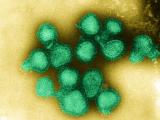Nov 6, 2009 (CIDRAP News) – Pandemic flu activity continues its vigorous spread across the United States, with 48 states experiencing widespread activity and reports of 18 more deaths in children, the US Centers for Disease Control and Prevention (CDC) said today.
Though the number of doctor's visits from flulike illnesses decreased slightly from the previous week from 8% of patient visits to 7,7%, it's difficult to tell if the activity is peaking, said Anne Schuchat, MD, director of the CDC's National Center for Immunization and Respiratory Diseases, at a media briefing today. She noted that activity waxes and wanes in different areas from week to week.
The CDC weekly flu surveillance report released today, which covers the week ending Oct 31, revealed:
- Lab-confirmed flu hospitalizations continued to climb.
- Pneumonia and influenza mortality rates increased for the fifth week in a row.
- More than 99% of subtyped flu viruses reported to the CDC were the pandemic H1N1 virus.
- Two seasonal H3N2 viruses that the CDC has received since Sep 1 were related to the Perth strain that is not included in the Northern Hemisphere's seasonal flu vaccine, but is a component of the Southern Hemisphere's vaccine, and the CDC has said it is too early to predict if circulating seasonal strains will be a good match with the seasonal vaccine.
So far manufacturers have made 38 million doses of pandemic H1N1 vaccine available to states, which is up 11 million doses from a week ago, she said. Most of the vaccine shipments coming out now are the injectable version, with about one-third of the supply as the inhaled version.
The more plentiful shipments of injectable vaccine come as good news for public health officials who are scrambling to vaccinate high-risk groups first. The inhaled version, which made up most of the earliest doses, is contraindicated for many vulnerable groups, such as pregnant women and children younger than age 2.
Though Schuchat held off on making longer-range vaccine output projections, she said if everything goes smoothly an additional 8 million doses should become available to states over the next week.
Getting vaccine to at-risk people
In response to reports that some corporate clinics have received some supplies of pandemic vaccine to distribute to employees, Schuchat said state and local officials are working hard to put the vaccine in the path of high-risk patients, even if that means putting it in a setting where they can easily get the vaccine at their workplace clinic. Yesterday the New York Times and other media outlets reported that New York City health officials distributed small amounts to businesses, including to some Wall Street firms.
The story has prompted anger and speculation that businesses might use their doses for executives and others that are not in high-risk groups. Yesterday the CDC sent a letter to state health departments reminding them to target scarce vaccine doses to high-risk patients. Schuchat did not directly link the letter to reports of businesses receiving vaccine doses.
She added that over the past several years, businesses have been instrumental in getting seasonal vaccine into the arms of Americans. She said states are using a range of strategies for getting the vaccine to high-risk groups.
For example, she singled out a drive-up vaccination clinic that public health officials in the Champaign-Urbana, Ill., area are using to deliver doses to children with special needs.
However, Schuchat said CDC officials acknowledge that the slow flow of pandemic vaccine has hampered state and local efforts to direct patients to the shots. Today a poll from the Harvard School of Public Health showed that only half of adults were able to determine where to get the vaccine.
Since vaccine campaigns launched in October, only a third of parents who tried to get their children vaccinated were able to do so, and only about one third of high-risk adults were able to find doses for themselves.
Schuchat said the good news in the Harvard survey was that 91% of those who attempted unsuccessfully to find the vaccine said they would try again to get it. The Harvard survey, part of an ongoing series, was based on a national sample of 1,073 adults.
Antiviral options
Though the scarce supply of vaccine in the face of such widespread flu activity is frustrating, Schuchat said antivirals are another very effective tool in fighting the virus. Today the CDC e-mailed a health advisory to clinicians reminding them that it's not too late to start a patient on antiviral treatment, even if their symptoms began more than 48 hours prior, which has been the optimal treatment window.
Those who benefit from even later treatment with antivirals include not just hospitalized patients, but also outpatients with underlying health conditions and any moderately ill patient who appears to be getting worse.
People without risk factors can also benefit from treatment, the CDC said, pointing out that 40% of children and 20% of adults who were hospitalized with pandemic H1N1 infections did not have underlying risk factors.
The CDC also reiterated that antiviral treatment should be started empirically in patients with suspected infections, without waiting for laboratory confirmation.
See also:
Nov 6 CDC weekly flu surveillance update
Nov 6 Harvard School of Public Health press release



















